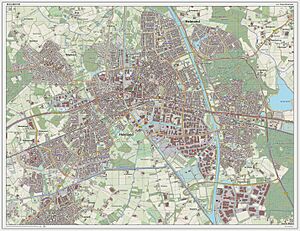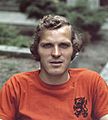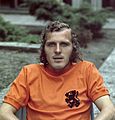Helmond facts for kids
Quick facts for kids
Helmond
Héllemond (Helmonds)
|
|||
|---|---|---|---|
|
City and municipality
|
|||
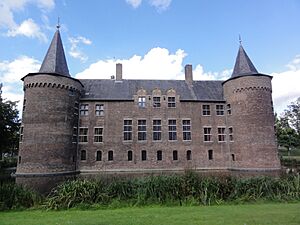
Helmond Castle
|
|||
|
|||
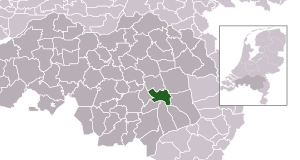
Location in North Brabant
|
|||
| Country | Netherlands | ||
| Province | North Brabant | ||
| Government | |||
| • Body | Municipal council | ||
| Area | |||
| • Total | 54.75 km2 (21.14 sq mi) | ||
| • Land | 53.23 km2 (20.55 sq mi) | ||
| • Water | 1.52 km2 (0.59 sq mi) | ||
| Elevation | 18 m (59 ft) | ||
| Population
(May 2014)
|
|||
| • Total | 89,472 | ||
| • Density | 1,681/km2 (4,350/sq mi) | ||
| Demonyms | Helmondenaar, Helmonder, Helmonter | ||
| Time zone | UTC+1 (CET) | ||
| • Summer (DST) | UTC+2 (CEST) | ||
| Postcode |
5700–5709
|
||
| Area code | 0492 | ||
Helmond is a city and municipality located in the southern Netherlands. It is part of the North Brabant province. The city is known for its history in textile and metal industries.
You can find the Vlisco factory in Helmond, which is right next to the Zuid-Willemsvaart canal. This canal runs through the city. People in Helmond speak a local dialect called Helmonds, which is a type of East Brabantian dialect.
Contents
- Discovering Helmond's Past
- Helmond's Layout: Quarters and Neighborhoods
- Getting Around Helmond: Transportation
- Helmond's Media Scene
- Famous Faces from Helmond
- Helmond's Sister Cities
- Images for kids
- See also
Discovering Helmond's Past
What's in a Name? The Story of Helmond's Coat of Arms
Helmond's coat of arms first appeared in 1241. It shows a helmet, which is a clever way to represent the city's name. In Dutch, "helm" means helmet.
However, the real meaning of Helmond's name might be different. It probably comes from two old words: "Hel" meaning "low-lying" and "Mond" referring to higher or safer ground.
The helmet on the coat of arms has changed over time. It used to look like a medieval knight's helmet. Now, it looks like a helmet used for jousting. The oak branches on the coat of arms stand for freedom. The bird sitting on them is just for decoration.
From Ancient Settlements to a Medieval City
Long ago, during the Merovingian period, the area where Helmond is now was a wet place with many streams. As the streams filled with dirt, it became possible for people to live there. Around the year 1000, a settlement grew west of the current city center.
An early version of Helmond Castle, called 't Oude Huys (meaning "the old house"), was built around this time. In 1108, documents mention Lord Hazelo von Helmond, who was the first feudal lord of the area.
In 1179, a special letter from Pope Alexander III mentioned Helmond being given to the Abbey of Floreffe. The local leaders likely moved their offices to 't Oude Huys.
How Helmond Became a Town
In 1220, Henry I, Duke of Brabant took control of Helmond. He officially founded the town in 1225. Helmond received its Town Privileges in 1232. This meant it had special rights, like holding markets.
After Henry's death in 1235, his daughter, Maria of Brabant, Holy Roman Empress, inherited the town. She spent a lot of time at 't Oude Huys. Her founding of Binderen Abbey helped the city grow. When she died in 1260, the town went back to the Dukes of Brabant.
In 1315, the Dukes leased Helmond to the van Berlaer family. In 1325, Jan II Berthout van Berlaer began building a stone tower where Helmond Castle now stands. This new castle replaced 't Oude Huys. By 1400, the city walls were built to protect the town.
Growth and Challenges in Medieval Helmond
Helmond gained market rights in 1376, which helped its textile industry grow. By 1389, seven guilds (groups of skilled workers) were allowed to operate in the town. Merchants from Helmond sold wool and textiles all over Brabant.
Even with this business growth, the town's population stayed small. Helmond's good times ended due to wars and problems in the Duchy of Guelders. In 1543, the army of Maarten van Rossum attacked and looted Helmond.
Helmond Through Wars and Changes
Helmond was also involved in the Eighty Years' War. The city supported Philip II of Spain. The army of the Dutch Republic captured and lost the city twice. Only the castle remained safe.
The war and a plague in 1636 severely damaged Helmond's textile industry. Many weavers left for Haarlem. The city only began to recover after peace was made in 1648. Helmond's weavers then formed a good partnership with merchants in Haarlem, helping the city rebuild.
The French Influence and New Beginnings
In the late 18th century, Helmond faced more instability during the Patriottentijd. After some fights, the Patriots (who wanted more freedom) were defeated in 1787. However, just five years later, in 1793, the French Republic invaded.
The French government was more liberal. This allowed the Patriots to regain power in Helmond. In 1795, all men in Helmond were allowed to vote. By 1798, the old Dutch Republic was gone, and Catholics were allowed to take part in city government again.
The Rise of Industry in the 19th and 20th Centuries
By the late 1700s and early 1800s, local business owners started to grow the textile industry on their own. This led to more industrial production. Helmond became a city with a voice in the Estates of Brabant in 1814.
The opening of the Zuid-Willemsvaart canal in 1826, which runs through the city, brought more wealth to Helmond. Besides weaving mills, other textile businesses grew, like cotton printing and dyeing plants.
Modernization and World War II
The introduction of steam power and the building of a railway station in 1866 greatly sped up Helmond's development. The city's population grew a lot. By the early 1900s, Helmond's industries expanded beyond textiles. They started producing metal products like machines and wires. A cocoa factory, a margarine factory, and the EDAH grocery chain also opened.
In 1940, the German army captured Helmond. The city's government was taken over by people who supported the National Socialist Movement. The British Army freed the city on September 24 and 25, 1944.
After the war, industry in Helmond thrived again. New companies started, and old ones continued to grow. To show a modern image, famous buildings like the Cube Houses were built. Helmond reached 80,000 residents in 1999 and continues to grow today.
Helmond's Layout: Quarters and Neighborhoods
Helmond is divided into different areas called quarters and neighborhoods. Here are some of them:
- Quarter 11 Inner City
- Neighborhood 0 Centrum
- Neighborhood 2 Leonardus
- Neighborhood 3 Heipoort
- Neighborhood 4 Stationsgebied
- Neighborhood 5 Vossenberg
- Neighborhood 6 Annabuurt en Suytkade
- Neighborhood 7 Steenweg en omgeving
- Quarter 11 Helmond-East
- Neighborhood 0 Beisterveld
- Neighborhood 1 Beisterveldse Broek
- Neighborhood 2 Straakven
- Quarter 12 Helmond-North
- Neighborhood 0 Bloemvelden
- Neighborhood 1 Binderen
- Neighborhood 2 Eeuwsels
- Quarter 13 Mierlo-Hout
- Neighborhood 0 't Hout-Centrum
- Neighborhood 1 Kroon
- Neighborhood 2 Akkers
- Neighborhood 3 Gansenwinkel
- Neighborhood 9 Groot Goor
- Quarter 14 Brouwhuis
- Neighborhood 0 Brouwhuis-Dorp
- Neighborhood 1 Brouwhuis-West
- Neighborhood 2 Brouwhuis-Oost
- Neighborhood 4 Brouwhorst
- Neighborhood 9 Kloostereind
- Quarter 15 Helmond-West
- Neighborhood 0 West
- Neighborhood 1 Houtsdonk
- Quarter 16 Warande
- Neighborhood 0 Oranjebuurt
- Neighborhood 1 Zwanenbeemd
- Neighborhood 9 Overbrug
- Quarter 17 Stiphout
- Neighborhood 0 Stiphout-Dorp
- Neighborhood 1 Schooten
- Neighborhood 9 Geeneind
- Quarter 18 Rijpelberg
- Neighborhood 1 Rijpelberg-Oost
- Neighborhood 2 Rijpelberg-West
- Neighborhood 9 Berkendonk
- Quarter 19 Dierdonk
- Neighborhood 0 Kern Dierdonk
- Neighborhood 9 Scheepstal
- Quarter 21 Brandevoort
- Neighborhood 1 De Veste
- Neighborhood 2 Schutsboom
- Neighborhood 3 Stepekolk
- Neighborhood 4 Berenbroek
- Quarter 29 Industrial park-South
- Neighborhood 1 Hoogeind
- Neighborhood 2 B.Z.O.B.
Getting Around Helmond: Transportation
Helmond has several railway stations that help people travel in and out of the city:
- Helmond
- Helmond Brouwhuis
- Helmond Brandevoort
- Helmond 't Hout
Helmond's Media Scene
Here's how people in Helmond stay informed and entertained:
Newspapers
- ED - Helmond Plus
- ZondagNieuws (meaning: SundayNews)
- De Traverse
- De Loop
Radio Stations
- Omroep Helmond (Radio) (meaning: Helmond Broadcasting (Radio))
- Internetradio Helmond Sport
Television
- Omroep Helmond (TV) (meaning: Helmond Broadcasting (TV))
Online News
- Alles Over Helmond (part of Omroep Helmond) (meaning: Everything About Helmond)
- De Weblog van Helmond (meaning: Helmond's weblog)
Famous Faces from Helmond
Many notable people have come from Helmond:
- Lucas Gassel (around 1490-1570) – A Flemish Renaissance painter known for landscapes.
- Anthonius Konings (1821-1884) – A professor and writer on theology.
- Theodorus Willem van Lidth de Jeude (1853–1937) – A Dutch zoologist who studied reptiles and amphibians.
- Matthijs Vermeulen (1888–1967) – A Dutch composer and music journalist.
- Willem Zeylmans van Emmichoven (1893-1961) – A Dutch psychiatrist.
- Franz Jozef Van Beeck (1930-2011) – A Dutch priest, author, and Christian theologian.
- Elly Blanksma-van den Heuvel (born 1959) – A politician and former bank manager, she has been the Mayor of Helmond since 2012.
- Harry van Bommel (born 1962) – A politician and activist.
- Diana van Berlo (born 1966) – A former member of the disco/pop girl group Luv'.
- Stochelo Rosenberg (born 1968) – A Gypsy jazz guitarist who leads the Rosenberg Trio.
- M. H. Benders (born 1971) – A Dutch poet and philosopher.
Sports Stars from Helmond
Helmond has also produced many talented athletes:
- Willy van der Kuijlen (1946–2021) – A Dutch football player.
- Lisette Sevens (born 1949) – A field hockey player who won a gold medal at the 1984 Summer Olympics.
- René and Willy van de Kerkhof (born 1951) – Twin brothers and former footballers.
- Fieke Boekhorst (born 1957) – A field hockey player who won a gold medal at the 1984 Summer Olympics.
- Berry van Aerle (born 1962) – A Dutch retired footballer.
- Hans Gillhaus (born 1963) – A Dutch retired footballer.
- Pieter Gruijters (born 1967) – A Paralympic athlete.
- Wilfred Bouma (born 1978) – A Dutch former footballer.
- Nieky Holzken (born 1983) – A Dutch kickboxer and professional boxer.
- Bob de Voogd (born 1988) – A Dutch field hockey player who won a silver medal at the 2012 Summer Olympics.
Helmond's Sister Cities
Helmond has special connections with other cities around the world. These are called twin towns or sister cities:
|
|
Images for kids
See also
 In Spanish: Helmond para niños
In Spanish: Helmond para niños



